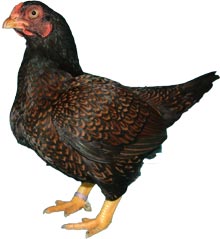Here is a list of traditional meat breed/table poultry crosses that can be used to create your own hybrid chickens for the table.
These birds are called table birds, fryers, broilers, meat birds or roasters. Generally speaking, the faster a bird grows, the more tender the meat is but there are extremes. Typical supermarket chicken in the UK takes just 39 days to grow.
Normal pure breeds of chickens take 20 weeks to grow. The commercial birds are bought as chicks from companies who have invested heavily in maintaining parent stock, effectively their own ‘breeds’ that produces very fast-growing offspring of a suitable size for the table. This comes at a price. There are losses of 10% in typical operations which is very high.
Table poultry at home
For the hobby poultry keeper wanting to keep a few chickens for meat, it is very hard to buy a few fast-growing commercial table birds as they are usually sold by the thousand.
Traditional pure breed crosses are slightly slower to grow but many people are turning towards slower-growing chickens that have a fuller flavour (if you do purchase these faster-growing commercial birds then read Fast Food: Raising Broiler Chickens for some hints).
The following traditional table chicken hybrid crosses will grow in 8 to 10 weeks, are broad-breasted. Most have white feathers and skin for a clean carcass and white skin.
- Light Sussex X White Wyandotte
An excellent table chicken but care must be taken in selecting the breeders so the breast bone of the offspring is not too high.
Care should also be taken in selecting the White Wyandotte hens, they must not have any black in the legs in order to get good white-fleshed table bird. These are fast-growing birds that are short-legged, carrying lots of meat.
Feathers are white with the odd black fleck. Almost all of these birds will be white-fleshed.
- White Wyandotte X Light Sussex
Take care in selecting the White Wyandotte Cocks, they must not have any black in the legs in order to get good white-fleshed table bird.
Some chicks will have a yellow skin but other than this, the resulting birds are much the same as the Light Sussex X White Wyandotte cross mentioned above.
- Indian Game X Rhode Island Red
 This produces a yellow-skinned bird which can be greatly enhanced in colour by feeding maize and allowing access to fresh green grass.
This produces a yellow-skinned bird which can be greatly enhanced in colour by feeding maize and allowing access to fresh green grass.
The Rhode Island Red is a fast-growing breed which dominates the slower-growing Indian Game. Indian Game cocks should be at least a year old so that fertility is high. Since Rhode Island Reds are prolific layers, there is never any shortage of hatching eggs.
The Indian Game (right) has a very broad breast.
- Indian Game X Sussex on Light Sussex
This is a second cross that was once very popular to produce a very meaty white-fleshed table bird. The first cross results in slow growth but the second results in very fast growth.
If you buy Indian Game crosses as table birds from a hatchery, often they will use second-generation crosses of some of these birds, so the parents are crosses themselves.
Discussion
- Please leave us a comment below if you have a question or can provide further information about table poultry.




